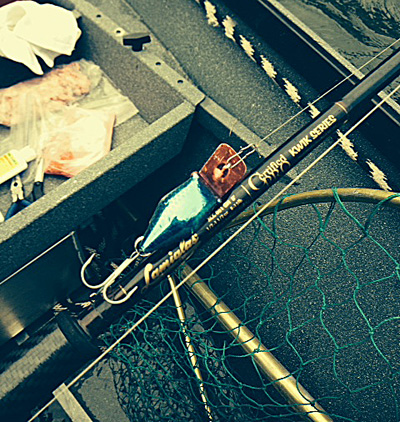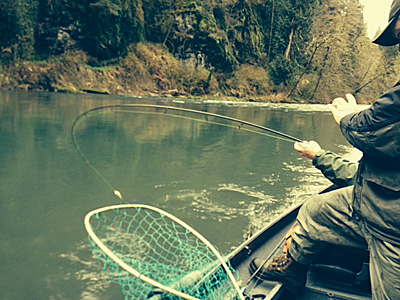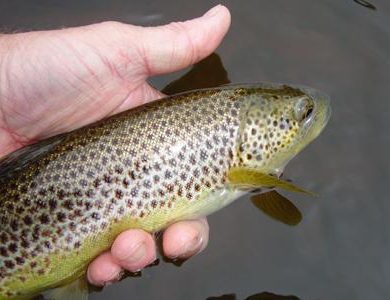Cold. Biting cold.
A thin constant drizzle of icy water everywhere and a mist of it soaked into my hands, turning them into pink, wrinkled, shrivelled pads barely able to cope with holding the rod; tying a knot would be totally out of the question.
There is no such thing as bad weather, there is only inappropriate clothing – or so goes the saying; it is true and it certainly applied to me, sitting in a metal drift boat on the Kalama river, three hours south of Seattle, which, for the geographically challenged, is on the Pacific West Coast of the USA and is fishing paradise – if, that is, you can put up with the cold and the rain.
The last weeks of March were still convinced it was winter and refused to allow spring to come to the party. My single tiny suitcase, with enough to last me just one week, was unable to accommodate proper winter wet weather gear and I certainly was not going to buy a full set when I had perfectly good stuff at home – so I suffered the cold for my passion – again.
My old friend Fred (ex-homicide cop, don’t argue with him, he has guns!) had picked me up at the airport and as usual had rolled out the red carpet to make me feel as much at home as possible. He’d even found a pair of waders I could get into and a rubberised coat to fit over all my existing clothes. But it was still as cold as a witch’s tit.
We had originally booked two days with our fishing guide, Steve Leonard, in the hope of knocking a couple of holes in my bucket list. In the end it transpired that we were not equal to the weather and had to cancel day two because we were wrecked from day one.
I wanted a spring chinook salmon and a genuine NW Pacific steelhead, having only caught the Great Lakes river version before but with a five day window of opportunity before my plane returned to the UK, it was going to be touch and go. The rivers were up and no chinook had been reported running yet. The Columbia River, our best bet, was over its banks and unfishable. However, the good news was that the nearby Kalama River was just about back on form, meaning a steelhead was a possibility. Steelhead are sea-run rainbow trout which return to the river to spawn, the same as our sea trout here in the UK – and I can confirm that when hooked they go like **** off a shovel!
 A pre-dawn start and only two hours sleep. As I get older I find it harder to adjust to time zone changes. We arrived at the river at 7am after a two hour drive to find it a perfect ‘steelhead green’ colour but with a lot of water still punching through.
A pre-dawn start and only two hours sleep. As I get older I find it harder to adjust to time zone changes. We arrived at the river at 7am after a two hour drive to find it a perfect ‘steelhead green’ colour but with a lot of water still punching through.
Launching the boat looked to be a hazardous task but our guide managed it single-handedly with ease – he’s done this before. With Fred taking the front seat, Steve on the oars in the middle and me shivering in my borrowed, ill-fitting waders at the stern we set out on a six mile drift downstream.
Did I mention the weather? It was perishing…
Steve had brought a couple of fly-rods after hearing in advance I was after a steelhead on the fly. But in this weather? I bravely stood up to the task and waded out in the river on a few occasions but with the howling gale sandblasting me with ice shreds I struggled to cast the heavy line. Fifteen minutes at a time was all I could stand, then it was back to the relative comfort of the boat and fishing lures or bait.
The Americans can teach us so much when it comes to lure fishing and I always seem to manage to learn something new from them. This time it was a lure method I have never before used: Hotshotting, suitable only on a fast river for predatory or aggressive species. That kind of limits its use in the UK as we don’t have a lot of target fish fitting the bill – but I think, or hope, it could be a winner for salmon – it certainly works on steelhead!
A Hotshot is a short stubby plug with a single treble at the rear and a long diving vane at the front end. It’s an old design which has been around for over fifty years but it is remarkable effective.
 You fish it by anchoring the boat in a fast glide – over gravel, preferably – and letting out 40 to 60ft of line and then you just hold the lure in place, there’s no retrieving. The power of the current forces the nose of the plug down until it starts head-butting the gravel and dancing in the stream. There are one or two bank swims I can think of on the Wye where this lure would be useful, but not many as it really it needs a boat to get the best from it because it is effectively fished as a ‘static’ lure. Every few minutes it’s worth reeling in to check the hooks have not picked up any debris, conditions determine how regularly you need to do this.
You fish it by anchoring the boat in a fast glide – over gravel, preferably – and letting out 40 to 60ft of line and then you just hold the lure in place, there’s no retrieving. The power of the current forces the nose of the plug down until it starts head-butting the gravel and dancing in the stream. There are one or two bank swims I can think of on the Wye where this lure would be useful, but not many as it really it needs a boat to get the best from it because it is effectively fished as a ‘static’ lure. Every few minutes it’s worth reeling in to check the hooks have not picked up any debris, conditions determine how regularly you need to do this.
The other method we used on the day was float fishing a bait in a manner we Brits would usually laugh at, but again it works here, so why not at home?
 ‘Side drifting with bobbers’ involves fishing a sliding float several feet over depth. We moored up on the inside of a bend then cast upstream to the top of the run allowing the float (a Drennan pike waggler, or similar) to be dragged by the current through the swim with the float preceding the bait and the weight dragging the bottom, but giving a visual indication of the course the bait is going to follow. The weight we were using (a bunch of shot in a bag) was a horrible affair which tangled on the cast; a drilled bullet with a plastic liner would have been a better arrangement, or even a twist of lead wire, but the method worked well enough. The bait was salmon eggs – illegal back home but very common out here.
‘Side drifting with bobbers’ involves fishing a sliding float several feet over depth. We moored up on the inside of a bend then cast upstream to the top of the run allowing the float (a Drennan pike waggler, or similar) to be dragged by the current through the swim with the float preceding the bait and the weight dragging the bottom, but giving a visual indication of the course the bait is going to follow. The weight we were using (a bunch of shot in a bag) was a horrible affair which tangled on the cast; a drilled bullet with a plastic liner would have been a better arrangement, or even a twist of lead wire, but the method worked well enough. The bait was salmon eggs – illegal back home but very common out here.
We hooked six fish I think, because it got a bit exciting for a while, with five landed. All bar one were in the 9 to 12lb range, with one a hatchery fish kept for the pot whilst the other wild fish were returned. All came to the bait except the first fish which fell to my Hotshot lure.
There are guys who fish the Kalama River all the time who dream of a 20lb steelhead; I was lucky enough to catch one on my first attempt!

